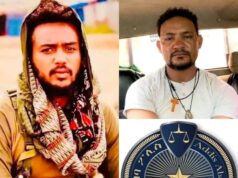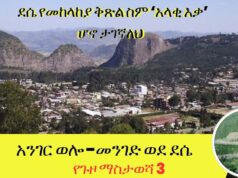Awol K Allo
Lying to the southeast of Ethiopia’s capital Addis Ababa is Bishoftu, home to the Ethiopian Air Force and Lake Arsadii, the site of the Irreecha, the most important cultural festival for the more than 40 million ethnic Oromos. A bustling resort town famous for its crater lakes and picturesque landscape, Bishoftu is striking rather than beautiful. It is too hollow and too sentimental to be beautiful.
WATCH: Ethiopia’s bereaved families seek justice (2:30)
The city, in which millions of Oromos gather each year in late September or early October to celebrate the wholeness and deep magnificence of nature and culture, was the scene of the deadliest atrocities (pdf) in the yearlong anti-government protests in which security forces have killed more than 1,000 people.
October 2, 2017 marks the first anniversary of the Irreecha atrocity in which the sacred grounds of Bishoftu desecrated as security forces used tear gas and live bullets against an agitated crowd of about two million assembled on the shore of Lake Arsadi. In the utter chaos and confusion that ensued when the massive crowd began to run, people fell into deep ditches, trampled, suffocated, got shot, and drowned in the nearby lake.
Shortly after the tragic event, the government blamed “anti-peace forces”, a common lexicon attached to activists and dissenting voices with fatal consequences, for triggering a deadly stampede. Activists on their part accused the government of perpetrating an “intentional and planned massacre” of innocent civilians gathered to give thanks and celebrate the deep and true beauty and significance of the Irreecha.
OPINION: The Oromo protests have changed Ethiopia
While there is no independent and credible inquiry into the causes and consequences of the tragedy yet, the contestation to control the narrative, the struggle to fix the history and memory of the 2016 Irreecha, began in earnest before victim’s bodies identified and properly grieved by their survivors. The government puts the death toll at 55 while the opposition Oromo Federalist Congress Party reported the death of 678.
Although there is no evidence yet that there was a premeditated, programmatic, and purposeful killing of innocent civilians, these deaths are not the result of a fatal flaw or aberrations committed by rogue security forces.
An atrocity
The government resisted calls for an independent and credible inquiry into the causes and consequences of the stampede, but a new report (pdf) published by Human Rights Watch provides a rich account of what transpired at the 2016 Irreecha Festival. Based on interviews with more than 50 individuals who attended the festival and an analysis of dozens of video footage and photos, the report concluded that not only did security forces trigger the stampede; they also used disproportionate force – including live bullets – without any imminent threat to their security.
Although there is no evidence yet that there was a premeditated, programmatic, and purposeful killing of innocent civilians, these deaths are not the result of a fatal flaw or aberrations committed by rogue security forces. Rather, they are a foreseeable consequence of structural forces – prior policy choices, institutional practices, and attitudes – that were central to maintaining and sustaining the prevailing configuration of power. This institutional culture meant that violent actions that are patently illegal and foreseeably lethal become morally excusable and legally defensible when perpetrated by security forces in the name of national security.
The 2016 Irreecha came after a yearlong protest by the Oromos against systemic and structural inequalities at the heart of Ethiopia’s multinational federal experiment. Over the last quarter of a century, the government tried to maintain power by concealing the exploitative and abusive arrangements and bureaucratic procedures through the policy of divide and rule and the consolidation of economic and militarised patronage. When the protests sparked, the government quickly framed protesters as “terrorists” and “anti-peace forces”, providing a prior justification for its increasingly violent use of force against an already terror-stricken community. In 11 months, security forces killed over 1,000 people and detained tens of thousands.
OPINION: The ‘Ethiopia rising’ narrative and the Oromo protests
Given the escalating confrontation and the violence preceding the festival, security forces should have known and did know, that firing live ammunition and tear gas, including from a helicopter, into an already terror-stricken and agitated mass, can result in mayhem.
The Irrecha atrocities are the direct consequence of those structural policies and institutional attitudes designed to maintain existing arrangements of power between the ruling elites and their subjects. Academic Brenda K Uekert characterises such killings that occur “when the state, often authoritarian, felt threatened” as political atrocities.
Fixing history and memory
Standing about 2km to the North East of Lake Arsadi is a new cenotaph erected by the Oromia regional government to commemorate those who lost their lives as they gave thanks and celebrated the deep and true beauty of the Irreecha. Echoing the government’s attempt to control the narrative and fix the memory and history of Irreecha 2016, an inscription on the monument reads: “Memorial monument for those who lost their lives on Sudden Death during Irrecha Celebration at Hora Harsadi on October 2/2016”.
INSIDE STORY: What’s fuelling protests in Ethiopia? (25:15)
Contrary to the widely accepted view within the Oromo community that this was a deliberate massacre, the government wanted to construct a tale of a “sudden death” caused by a “stampede” triggered by “anti-peace forces”, exonerating the government and security forces from moral and legal responsibility. The reference to the deaths as “incidental” erases the fundamentally violent nature of security forces and the institutional culture that made it possible from the historical record. The memorial monument is a vehicle used to transform the government’s narrative into a historical fact while simultaneously filtering non-official narratives of the 2016 Irreecha out of public memory and official history.
Memorial monuments are intimately linked to the consolidation or edification of the historical record and the production of collective memory. But the process of producing official historical account is not straightforward. It is not necessarily about remembering every iconic figure or every major event of national significance. It is an exercise in selective archiving, which entails deliberate erasures and convenient silences as a means of constructing politically preferred accounts of politically consequential events.
However, officially sanctioned histories are not particularly powerful instruments of controlling the narrative and the verdict of history. As the great French Philosopher Michel Foucault writes, beneath officially sanctioned history, counter-history operates to unearth “something that has been hidden, and which has been hidden not only because it has been neglected, but because it has been carefully, deliberately, and wickedly misrepresented”.
The Ethiopian government must adapt to the changes unfolding beneath its feet. Rather than try to overwrite a narrative that has already taken root with a monument, it must allow an international investigation for an independent and credible determination of the causes and the consequences of the Irreecha Atrocity.

























